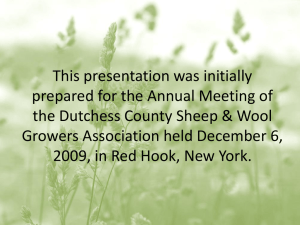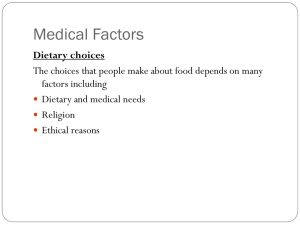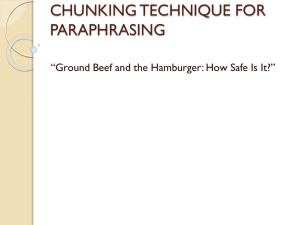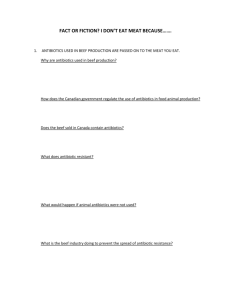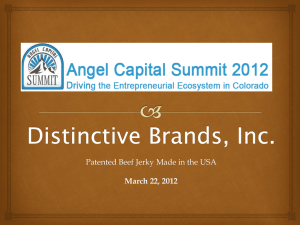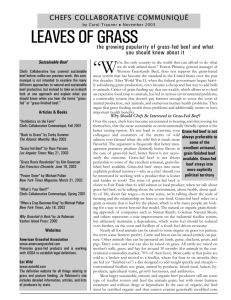Annotated_Bibliography_Sample_Grass_Fed
advertisement
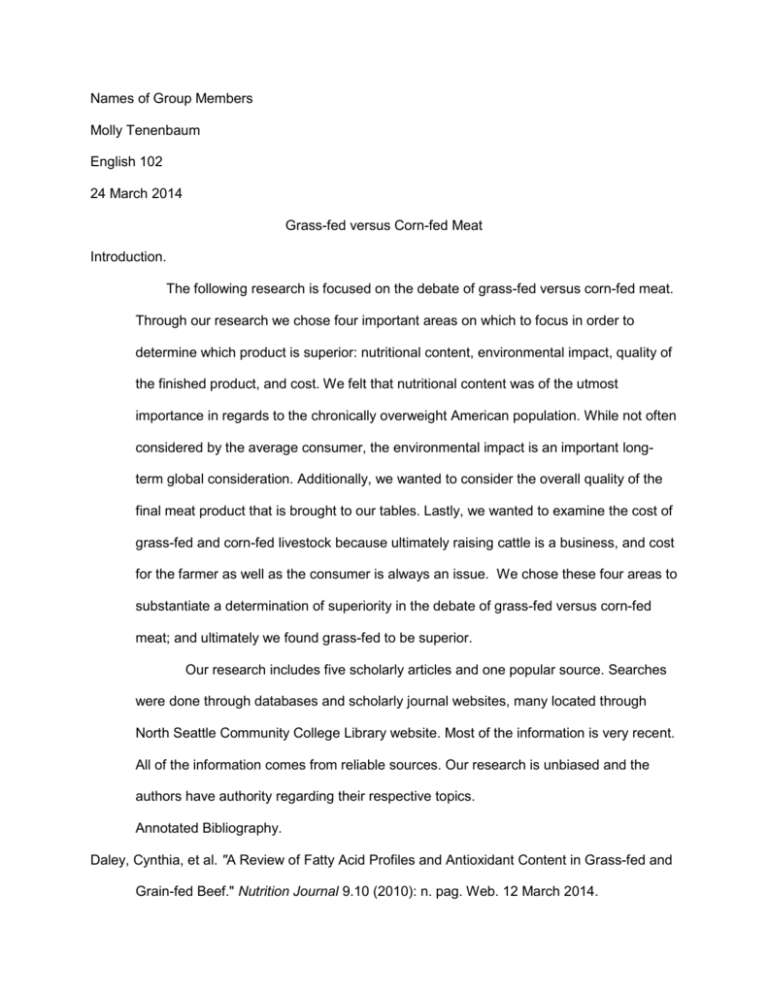
Names of Group Members Molly Tenenbaum English 102 24 March 2014 Grass-fed versus Corn-fed Meat Introduction. The following research is focused on the debate of grass-fed versus corn-fed meat. Through our research we chose four important areas on which to focus in order to determine which product is superior: nutritional content, environmental impact, quality of the finished product, and cost. We felt that nutritional content was of the utmost importance in regards to the chronically overweight American population. While not often considered by the average consumer, the environmental impact is an important longterm global consideration. Additionally, we wanted to consider the overall quality of the final meat product that is brought to our tables. Lastly, we wanted to examine the cost of grass-fed and corn-fed livestock because ultimately raising cattle is a business, and cost for the farmer as well as the consumer is always an issue. We chose these four areas to substantiate a determination of superiority in the debate of grass-fed versus corn-fed meat; and ultimately we found grass-fed to be superior. Our research includes five scholarly articles and one popular source. Searches were done through databases and scholarly journal websites, many located through North Seattle Community College Library website. Most of the information is very recent. All of the information comes from reliable sources. Our research is unbiased and the authors have authority regarding their respective topics. Annotated Bibliography. Daley, Cynthia, et al. "A Review of Fatty Acid Profiles and Antioxidant Content in Grass-fed and Grain-fed Beef." Nutrition Journal 9.10 (2010): n. pag. Web. 12 March 2014. The authors state that while red meat is regarded as an important source of essential amino acids and minerals- animal fats account for around 60% of the saturated fats in the American diet. This is troubling because an increased amount of saturated fat can lead to cardiovascular disease and other health problems. The source cites research spanning three decades that suggests that grass-only diets can alter the fatty-acid composition and improve overall antioxidant content of meat. In regards to beef, it has been found that grass-fed beef contains a higher content of vitamins, such as vitamins E, A, and Omegas 3 and 6, antioxidant enzyme content, and less overall fat than corn-fed beef. The grass-fed antioxidants, glutathione and superoxide dismutase, have anti-inflammatory and cancer fighting properties.The authors also address flavor profile, saying that grass-fed beef has historically been less preferred than grain-fed beef due to culinary habituation. The difference in taste is largely due to the decreased fat content of grass-fed beef when compared to corn-fed beef. In conclusion, grass-fed beef is preferred by the nutritional community, not only because it is lower in fat content, but because of the increased amount of important vitamins, minerals, and antioxidants that can be helpful in the American diet. Diez-Gonzalez, Francisco, and James B. Russell. "Grain feeding and the dissemination of acidresistant Escherichia coli from cattle." Science 281.5383 (1998): 1666+. Opposing Viewpoints in Context. Web. 23 Mar. 2014. Escherichia coli is a potentially deadly bacteria that is found in the intestinal tracts of many mammals, including humans. It is a natural bacteria that normally lives within the digestive tract. There are some types that are potentially deadly if not treated soon enough or at the very least can make a human very sick. In the digestive tract, the byproduct of grains, such as corn, is starch; the enzyme that breaks down starch is highly deficient in cattle. Consequently when livestock diet consists of grains such as corn that PH in digestive tract is lowered to 5.9(80% grain)–6.9(60%). The article demonstrates through extensive research that cattle given this much grain develop large amounts of PH resistant E-coli. Furthermore cattle given 80% hay or pasture (<20% grain) had a colonic PH of >7.0; overall this more neutral PH produced the least amount of E-coli and what was present was far less likely to be PH resistant E-coli. When the ecoli the cattle developed was exposed to a 2.0 PH pseudo human gastric juice for varying periods of time “virtually all of these bacteria were killed” from the hay/grass fed cattle while the grain fed e-coli lived in alarming numbers. Though the author states that it is unlikely that the U.S. will stop feeding cattle grain there was great evidence that if hay/grass feeding were done the last week or two before slaughter there is a tenfold lower PH resistant E-coli. Muir, P.D., et al. “Effects of forage- and grain-based feeding systems on beef quality: A review.” New Zealand Journal of Agricultural Research 41.4 (1998): n. pag. Web. 20 March 2014. The authors P. D. Muir, J. M. Deaker & M. D. Bown from the New Zealand Journal of Agricultural Research explain the different qualities of meats that people look at like marbling, fat content, juiciness and a few other categories. The study also explains how foraging and grain-feeding (grass vs. corn) affects these different qualities. There were a total of fifteen tests conducted that measured different aspects of the animals. These aspects included tasting the meat, observing the look and testing the chemical makeup of both corn and grass-fed meat. In blind taste tests, numerous people were unable to substantiate the difference between grass and corn-fed meat. All of the tests that were conducted followed certain criteria that made sure the animals were all prepared in the same manner before tests were conducted. This source is very helpful because it focuses on the quality that the consumer would be focused on. This source uses chemical findings to back up what can be seen and felt. Their findings are unbiased. The study was published in 2010, so the information is current for this topic. Pollan, Michael. “Power Steer.” The New York Times N.p., 31 March 2002. Web. 18 March 2014. According to Michael Pollan, corn-fed livestock is considered ‘old fashioned’. Corn is the cheapest and the most plentiful feed. At a low $2.25 a bushel, corn is the cheapest means of feeding our animals. It is actually 50 cents cheaper than the price to grow it. The surplus of grain is a result of modern factories. Since World War ll, the use of fertilizers has caused the amounts of surplus to soar. The U.S.D.A has a policy in place that allows farmers to dispose of surplus crops by feeding it to animals such as cows. This allows the farmers to feed thousands of cows in a small amount of space while staying within a budget. Pollan says that he believes that without cheap corn the urbanization of livestock would have never been possible. Because it is cheaper to feed cows with corn, it makes that beef cheaper in stores for consumers with shallow pockets. It is clear that it is cheaper to buy beef that was fed corn rather than grass. Corn is surplus and cheap, which is why farmers can feed many cows while budgeting. Even though it is cheaper to feed livestock with corn, the meat isn’t as nutritious as those fed with grass. Walton, Dr. Peter D. “Forage Crops.” AccessScience. McGraw-Hill Education, 2014. Web. 20 Mar. 2014. The article discusses the importance that foraging plants have on soil preservation. Forge plants that are allowed to develop a deep far reaching root system contribute greatly to the preservation of soil. These types of plants keep the soil from being eroded and after time will rebuild soil that has been left without topsoil due “row crop farming.” The vast majority of forge plants are perennials that return year after year. They can be grazed on several times throughout the growing season and overtime produce nitrates and sugars to sustainably fertilize themselves. While not directly mentioning corn, the article discusses the heavy toll that row farming has on the top soils, and corn happens to be a row crop. The article supports that grass feeding; feeding through forging crops such as various grasses and legumes, is a premier way to save our quickly depleting top soils that is both cost effective and long-term it is far better for the sustainability of our planet. This author is from Department of Plant Science, University of Alberta, Edmonton, Canada, with references to scientific and agricultural articles and books, and was accessed through McGraw Hill Education. Wood, J.D., and Enser, M. “Factors Affecting Meat Quality: Factors influencing fatty acids in meat and the role of antioxidants in improving meat quality.” British Journal of Nutrition 78.01 (1997): n. pag. Web. 18 March 2014. The authors of this article, J. D. Wood and M. Enser from the Division of Food Animal Science, School of Veterinary Science explains the factors that affect fatty acids in meat which is grass fed versus. corn fed. Some meat doesn’t have a high fat content to begin with but when their diets are changed one can see how the meat changes as well. With higher fatty acid content the flavor of the meat when cooked becomes different. Recent work with single stomach pigs has been done to try to change different acidity levels within the pig including the chemical that makes fatty acids. By doing this, ultimately you could feed the pigs either grass or corn based diets and simply change how it will affect the fatty acid content as well as other chemicals in the pig. Also a factor that contributes to the flavor and quality is the change in chemicals when there is a hold time for meat and the cooking process. The source is unbiased and talks about the quality of both meats and what is being done to make them more equal in their quality. It also gives examples of many different kinds of meat, not just beef which is most commonly mentioned by other sources. Conclusion: Our research explored the nutritional content, environmental impact, quality, and cost of grass-fed and corn-fed livestock to determine which is superior. The gross nutrition content of grass-fed livestock is superior to corn-fed because of less overall fat, higher amounts of vitamins, minerals and antioxidants. The environmental impact that feedlots have on an ecosystem is enormous and troubling; and even though grass-fed livestock require more space for grazing, when done sustainably, grazing systems produce natural fertilizers for the landscape. Cost is the major factor that keeps many people buying corn-fed meat when all of the evidence points to grass-fed as being superior. While opponents say that taste is also a factor, and that the general public prefers the increased marbling that appears in corn-fed meats, this culinary habituation is evolving as the science that proves that grass-fed meat is superior for the consumer and the environment is continuously overwhelming. Ultimately, based on nutritional value, quality, and environmental impact, our research concludes that grass-fed meat is better than corn-fed. Additionally, we found that the debate over grass-fed versus cornfed meat is showing encouraging signs of change within the food systems in America. We support farmers who are doing their part to produce a nutritious, sustainable product and hope to encourage others to do the same.




